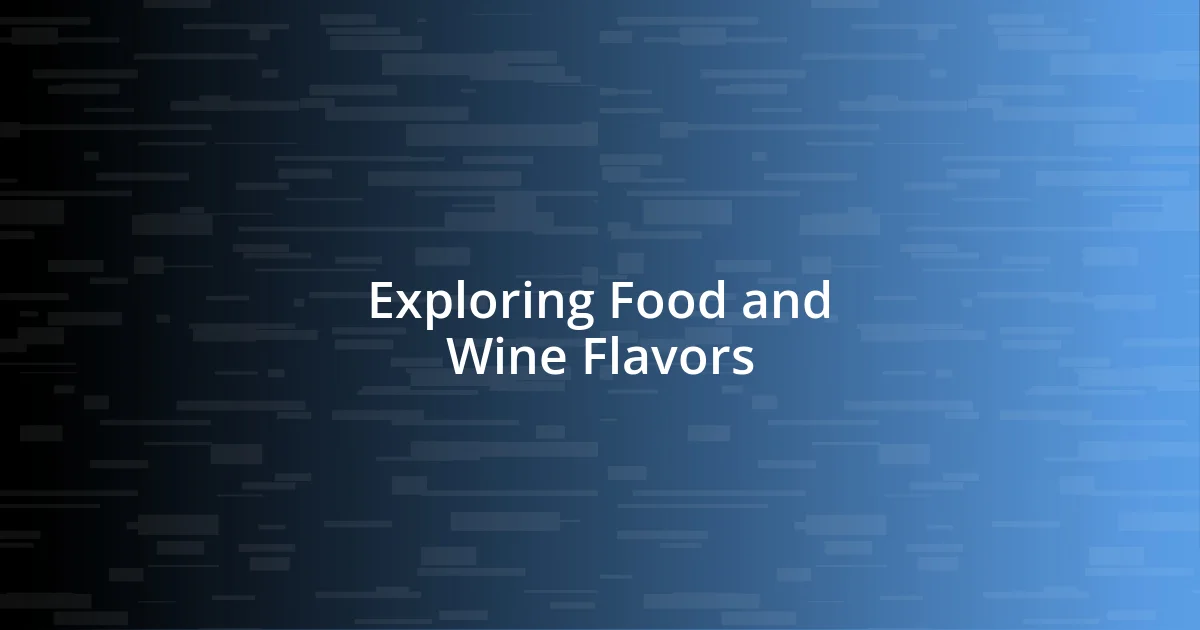Key takeaways:
- Understanding wine basics, such as acidity, tannins, and serving temperature, significantly enhances the wine-tasting experience.
- Choosing the right wine involves considering factors like dish flavor intensity, texture, seasonal ingredients, and the occasion.
- Experimenting with unconventional pairings can lead to delightful discoveries and memorable culinary experiences.

Understanding Wine Basics
When diving into the world of wine, I found it crucial to grasp a few fundamental concepts. For instance, understanding the difference between red, white, and sparkling wines can feel a bit overwhelming at first, but I recall the excitement I felt when I finally could distinguish a Cabernet Sauvignon from a Chardonnay. Have you ever sipped a wine and thought, “What makes this taste so different?” This curiosity can lead you to explore various grape varieties and winemaking processes.
Then there’s the all-important role of acidity and tannins in wine’s flavor profile. I remember attending a wine tasting, and the sommelier expertly explained how tannins create that puckering sensation in your mouth, especially in robust reds. This revelation changed how I perceived wine entirely—suddenly, I could appreciate how balance between acidity and tannins shapes the overall experience. Have you experienced a wine that just felt too sour or too bitter? Identifying these characteristics can enhance your pairings significantly.
Finally, let’s talk about the importance of temperature. I used to serve red wine too warm, thinking it would mellow the flavors, but boy, was I wrong! Serving a lighter red slightly chilled can elevate its freshness. Have you ever wondered why your wine doesn’t taste as vibrant as advertised? Temperature can be a game changer, and it’s an aspect I’ve come to respect deeply in my wine journey.

Choosing the Right Wine
Choosing the right wine can feel like navigating a labyrinth, especially when there are countless options available. I still remember that moment during a dinner party when I paired a deep Merlot with a savory mushroom risotto. The combination was so harmonious that it sparked a discussion at the table about how the earthy flavors of the dish were beautifully complemented by the wine’s soft, velvety texture. It taught me that pairing is not just about matching flavors; it’s about creating a conversation between the food and the wine that enhances both experiences.
To choose the right wine, consider the following factors:
– Match the body: Heavier dishes need fuller-bodied wines, while lighter fare pairs well with lighter wines.
– Think about flavor profiles: Look for complementary or contrasting flavors; a sweet dessert could be delightful with a sparkling wine.
– Consider occasion and mood: A casual gathering might call for a fun, easy-drinking wine, while a formal event may warrant something more refined.
– Know your audience: If you’re entertaining friends who love bold reds, don’t shy away from a robust Cabernet.
– Experiment and have fun: I’ve made mistakes and discovered hidden gems along the way, like pairing a spicy Asian dish with a semi-sweet Riesling—unexpectedly delightful!
Wine pairing is as much about personal taste as it is about guidelines, and that journey leads to some of my favorite culinary memories.

Key Factors for Pairings
When considering wine pairings, one of the key factors I always keep in mind is the dish’s flavor intensity. I recall the first time I paired a zesty Sauvignon Blanc with a tangy lemon herb chicken. The bright acidity of the wine lifted the flavors of the dish beautifully, creating a refreshing balance. It’s this understanding—that sometimes a harmonious match lies in contrasting intensity—that has truly enriched my dining experiences.
Another essential factor is texture. I remember hosting a cozy dinner where I served braised short ribs alongside a luscious, silky Cabernet Sauvignon. The wine’s smoothness hugged the rich, tender meat, making every bite and sip an indulgent delight. The interplay of texture can turn a meal into a memorable occasion, and I’ve learned to pay attention to this aspect more closely over time.
Finally, seasonality plays a significant role in my pairing decisions. During a crisp autumn evening, I once enjoyed a spicy Zinfandel with roasted butternut squash soup. The warmth of the wine and the earthiness of the soup felt like a perfect embrace for the season. I find that aligning wine selections with seasonal ingredients not only enhances the meal but also heightens the enjoyment of each sip and bite.
| Factor | Examples |
|---|---|
| Flavor Intensity | Light wines with lighter dishes; bold wines with hearty meals |
| Texture | Silky wines with rich foods; crisp wines with delicate dishes |
| Seasonality | Fresh whites in summer; spicy reds in winter meals |

Exploring Food and Wine Flavors
Exploring food and wine flavors feels like embarking on a delightful adventure. I’ll never forget venturing into the world of pairing when I first tasted a bold Syrah with a spicy Moroccan tagine. The wine’s rich, dark fruit flavors melded effortlessly with the earthy spices, creating a symphony of tastes that danced across my palate. Isn’t it amazing how the right wine can elevate a meal from ordinary to extraordinary?
I often think about how important acidity can be in a pairing. When I paired a bright, citrusy Pinot Grigio with a creamy seafood pasta, the wine cut through the richness of the sauce, balancing the dish perfectly. It’s moments like these that make you realize just how transformative the right pairing can be. I can still recall the smiles around the table; there’s something special about sharing that discovery with friends.
Sometimes, the best pairings arise from joyful experiments. One rainy afternoon, I found myself with a spicy sausage pizza and no usual red on hand. I grabbed a fruity Rosé instead, and to my surprise, its refreshing notes complemented the heat and richness of the pizza in a way I had never imagined. It reminded me that wine pairing doesn’t have to be rigid; it’s all about personal taste and the joy of trying new combinations. How often do we confine ourselves to the “rules” when some of life’s best experiences come from breaking them?

Classic Pairing Techniques
One classic technique I’ve found incredibly effective is matching wine with the dominant flavor of the dish. I remember a summer gathering where I served grilled salmon alongside a chilled Chardonnay. The wine’s subtle oak notes paired brilliantly with the smoky char of the fish, creating a seamless experience. Isn’t it satisfying when a pairing feels so natural, like they were meant to be together?
Another technique is to consider regional pairings, which often reflect the local food culture. I once traveled to Italy and enjoyed a fragrant Chianti with a rustic pasta dish with tomato sauce and basil. This experience taught me that wines from a specific area typically complement the cuisine of that region, creating a sense of place in each sip. Have you ever noticed how some pairings just make sense because they come from the same roots?
Finally, I always think about balancing flavors, especially when I’m working with spicy or rich dishes. I vividly recall making a spicy shrimp stir-fry paired with a refreshing Riesling. The wine’s sweetness tamed the heat while enhancing the dish’s vibrant flavors. It’s moments like these that remind me how balance can elevate a meal, turning each bite and sip into a harmonious experience.

Experimenting with Unconventional Pairings
There’s something exhilarating about stepping outside the traditional wine pairing boundaries. I remember hosting a dinner party where I decided to serve a rich chocolate torte. Instead of the customary dessert wine, I poured a chilled sparkling wine that I never imagined would work. To my delight, the bubbles and light acidity cut through the dessert’s sweetness, creating a refreshing contrast that left my guests raving. Have you ever tried something out of the blue that surprised you? That rush of discovery is priceless.
One of my most whimsical pairings came about during a relaxed weekend. I had a leftover Chinese takeout—specifically, sweet and sour chicken—and, rather than reaching for a beer, I opted for a slightly chilled Gewürztraminer. The wine’s aromatic profile mirrored the dish’s sweet elements while its acidity embraced the vinegar-y zest of the sauce, transforming dinner into a lively culinary adventure. It made me think, why shouldn’t we treat our palates to unexpected friends at the table?
I’ve also found that certain unconventional pairings often spark some of the most memorable conversations. Last summer, while enjoying a picnic in the park, I matched a spicy mango salsa with a robust Zinfandel. The wine’s berry flavors mingled with the heat from the salsa, creating an unexpected yet joyful burst of flavors. It’s in these moments that you realize food and wine can be playful and fun. What do you think? Isn’t it exciting to unearth new pairings that become instant favorites?

Tips for Developing Your Palate
To develop your palate, I suggest starting with a simple practice: taste and compare. I had an eye-opening experience when I hosted a tasting night with my friends, where we sampled four different Sauvignon Blancs from various regions. The uniqueness in flavors—the grassy notes from New Zealand versus the citrus hints from California—taught me how subtle differences can enhance appreciation. Have you ever noticed how a single grape varietal can tell so many stories?
Another effective technique is to take notes. Initially, I thought it was a tedious task, but logging my impressions led to incredible insights. During my wine journey, I found that jotting down not just the tasting notes but also my emotions and sensations created a much richer tapestry of flavors in my memory. It really made me wonder—what if documenting my experiences could be the key to unlocking new pairings in the future?
Lastly, I can’t stress enough the importance of patience. It took me time to let my palate evolve, and I’ve learned to savor the moments of discovery. One evening, I revisited a robust Cabernet Sauvignon after a year, and to my surprise, its complexity revealed notes I’d never experienced before. It prompts me to ask—how often do we rush through our tasting experiences? Sometimes, slowing down and revisiting favorites is where the true magic happens.














